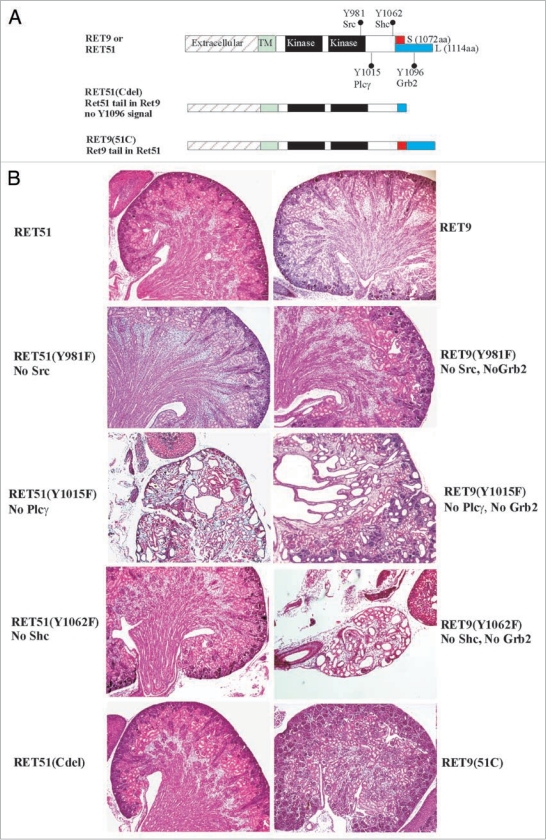Figure 4.
Roles of Ret isoforms and downstream cascades in kidney development. (A) Schematic of the different wild-type RET9, RET51 and their respective mutant knocked-in alleles. The different domains and sizes of the RET9 and RET51 alleles are indicated. The red and blue colors represent the area of divergence between the two RET isoforms. Also indicated are the key docking tyrosine (Y) residues. Homozygous mice were generated that harbor Tyr→Phe (Y→F) for each of the indicated Tyr except Y1096. RET51(Cdel) is an allele where residues 1063–1072 of RET9 were replaced with residues 1063–1072 of RET51 (results in receptor that is essentially similar to RET51 with deletion of residues 1073–1114, including Y1096). RET9(51C) is an allele where residues 1063–1072 of RET51 were replaced with residues 1063–1072 of RET9 (results in a receptor that is essentially similar to RET9 with C-terminus of RET51 including Y1096). (B) Hematoxylin-eosin-stained kidney sections of homozygous mice for the indicated knocked-in alleles at P0. Left column shows all the mutants in the context of ret51 isoform, and the right column in RET 9 context. Note wild-type forms of RET9 and RET51 have redundant functions in kidney development. Except for RET-Plcγ mutant RET51(Y1015F) individual abrogation of the key docking sites was dispensable. However, these same docking sites show dramatic kidney defects when the C-terminal Grb2 binding site is also deleted (mutations in RET9 context). Without Src and Grb2, there was a partially penetrant megaureter (see Fig. 7); without Plcγ (individually or without Grb2 site) kidneys are small and show cysts and dysplasia; without Shc and Grb2 (RET9-Y1062F), only kidney rudiments or agenesis is seen. Thus direct Grb2 binding site provides some redundancy to Y981 and Y1062 docking sites in kidney development. In these studies, swapping the 10 residues following 1063aa between the two isoforms did not appear to influence kidney development suggesting that differences in the isoforms are not due to these regions. Adapted and modified from Jain et al.42 with permission.

